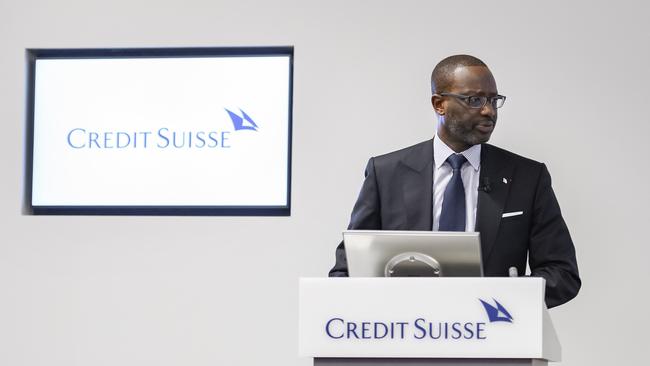Credit Suisse dodged the GFC, but it couldn’t avoid the cultural woes which hastened its demise
While UBS was clawing its way back from near death, Credit Suisse, which hadn’t required government money during the GFC, was going the other way.

In the weeks after the 2008 failure of Lehman Brothers, it was Swiss bank UBS teetering close to collapse and accepting government bailout funds, while Credit Suisse tapped a group of investors for support.
The net loss attributable to UBS shareholders in 2008 was a mammoth 19.7bn Swiss francs ($32.1bn) in the wake of its significant exposure to toxic assets and a wave of wealthy customers withdrawing funds.
UBS was then battered by a rogue trading scandal in 2011 and the bank’s woes continued. UBS subsequently clawed its way back by simplifying its model and concentrating on wealth management. Yet Credit Suisse, which hadn’t required direct government money during the financial crisis, was going the other way.
Serious compliance and risk issues were starting to emerge about a decade ago.
In a landmark 2014 case, Credit Suisse pleaded guilty to criminal charges that it helped Americans evade taxes – an admission that led to fines and restitution of about $US2.6bn being paid.
Credit Suisse’s more recent woes have been exacerbated by exposure to collapsed firms such as supply chain financier Greensill and Archegos Capital Management.
In another embarrassing blight on the firm, last year Credit Suisse was found guilty and fined for its links to money laundering by a Bulgarian drugs ring.
“Credit Suisse is suffering the consequences of bad management and that has come to the fore in a higher-interest rate environment,” says Dr Andy Schmulow, of the University of Wollongong’s School of Law.

“These things (compliance issues) get buried until a bank is under stress … what has happened to Credit Suisse may not necessarily be breaches in the prudential side, it’s breaches in the conduct and compliance side and that goes back to culture.
“It goes to the fecklessness of Swiss regulators who didn’t want to take on one of the biggest banks in the world; didn’t want to rock the boat.”
Prof Schmulow insists the Swiss authorities should have removed Credit Suisse board members in light of its many compliance missteps, to underscore the importance of robust governance.
“That’s exactly the same thing that’s happened in Australia. The prudential regulator has had the power under Section 11CA, subsection two, of the Banking Act to take people off the board of entities that were exposed at the Hayne commission for their bad conduct … and has never used it to this day.”
Credit Suisse found itself on its knees earlier this month, prompting the Swiss government and regulators to provide a 50bn Swiss franc loan facility as well as a short-term loan facility while urging calm, after banking markets and confidence were roiled by the collapse of three US financial institutions.
The situation was exacerbated by Credit Suisse shareholder Saudi National Bank saying it would not provide the former further financial assistance. The clock was ticking for Credit Suisse and this time – amid a crisis of confidence and outflows – regulators couldn’t see a way forward for the almost 167-year-old bank.
UBS agreed to buy Credit Suisse for more than 3bn Swiss francs in Switzerland last weekend, in an 11th hour transaction pushed by the Swiss government and regulators.
The landmark transaction was meant to head off fears of another global financial crisis-style event, albeit with different characteristics.
This time, central banks around the world were aggressively raising interest rates to tame inflation and investors were jittery after collapses in the US, including that of Silicon Valley Bank. The demise of SVB was linked to its exposure to the start-up sector and ill-timed government bond investments.

The shotgun takeover of Credit Suisse also created shockwaves for local staff as they were told it was business as usual in Australia until the transaction details were fleshed out.
Credit Suisse had a strong history in Australia’s investment banking landscape, working on deals such as the sharemarket listings of Telstra and Qantas, and the large electricity privatisation deals for the Victorian government. The firm also worked on Westpac’s $1.2bn rights issue in 1992, after the bank narrowly escaped its own collapse.
That raising’s documents controversially included a previously undisclosed tax liability in its New York operations, and Credit Suisse then picked up a shortfall on the transaction.
Data from Refinitiv shows that among Credit Suisse’s most successful years in equity capital markets were 2016 and 2010 when it finished the calendar year in third spot in the league tables. In mergers and acquisitions, Credit Suisse ranked number two in 2012, and the last time the firm finished a calendar year within the top five was 2013.
Former Credit Suisse Australia chief Rob Stewart says the group had good traction with larger local companies, due to its targeted approach.
“I learnt from amazing people and we worked on transactions that were really, really important for our clients,” he said.
“The (Australian) private bank is a world-class business; that was a strategy that made a lot of sense and has been very successful.”
Mr Stewart, who is a GIP Australia managing partner, took the reins at the helm of Credit Suisse in this market from David Livingstone in 2013.
Mr Livingstone took over the top job from Credit Suisse veteran David Trude, who led the firm’s operations for about a decade to 2010.
The Credit Suisse Australia business is now led by Richard Gibb, who was handed the baton by John Knox.
“In the early stages what really distinguished Credit Suisse was the quality of the people,” says Mr Knox, who leads Ares Management’s Australian and New Zealand business. “They were very much based on values, but very driven and impressive leaders as well.
“It truly was through the ’90s an investment in high-quality people.”
Mr Knox recounts among the key strategic shifts in the business were a 2015 move by then Credit Suisse group chief executive Tidjane Thiam to prioritise growth in the wealth operations over the investment bank.

“The other significant change that happened was the Australian investment banking business then reported into Asia and was no longer reporting in as part of global investment banking,” he said.
“The really big clients are global clients and you need a global team.”
The Australian investment banking market is often labelled over-banked by participants and investors, who will be closely watching to see how the takeover of Credit Suisse here plays out.
Like ABN Amro and CIMB it will disappear from the Australian takeover advisory market, while in institutional share trading, Deutsche Bank, Nomura and Commonwealth Bank no longer operate in that space.
Locally, rivals were circling Credit Suisse private bank customers and investment banking mandates this week in an attempt to capitalise on its demise and uncertainty relating to the UBS takeover.




To join the conversation, please log in. Don't have an account? Register
Join the conversation, you are commenting as Logout